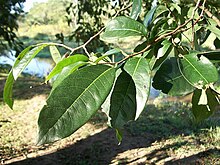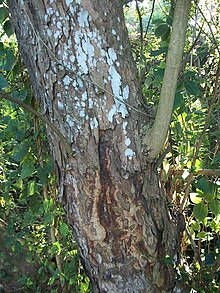| Margaritaria discoidea | |
|---|---|

| |
| Scientific classification | |
| Kingdom: | Plantae |
| Clade: | Tracheophytes |
| Clade: | Angiosperms |
| Clade: | Eudicots |
| Clade: | Rosids |
| Order: | Malpighiales |
| Family: | Phyllanthaceae |
| Genus: | Margaritaria |
| Species: | M. discoidea
|
| Binomial name | |
| Margaritaria discoidea | |
| Synonyms[2] | |
|
Phyllanthus discoideus (Baill.) Müll.Arg. | |
Margaritaria discoidea is a tree in the family Phyllanthaceae, commonly known as the pheasant-berry, egossa red pear or bushveld peacock-berry. These trees are native to the warmer, higher rainfall areas of Africa.
Taxonomy[edit]
This species has a complex taxonomic history with many synonyms (see taxobox); partially because of its morphological variability. These trees were formerly placed in the genus Phyllanthus and in the family Euphorbiaceae. 4 varieties are now recognized (1981), these having in the past been treated variously as distinct species, subspecies or synonymous with typical M. discoidea.[3] In KwaZulu-Natal, South Africa, there are 3 varieties:[4]
- M. discoidea var. discoidea
- M. discoidea var. fagifolia
- M. discoidea var. nitida
Distribution[edit]
This species is distributed from the coastal areas of the Eastern Cape,[4] South Africa, to tropical Africa,[4][5] as far as Senegal in West Africa.[5]
Description[edit]
A medium to tall tree in forest and riverine situations,[4] where it can grow up to 30 m tall,[6] or a shrub or small tree in dryer and more open situations.[4] The stem is usually straight with rough, flaking bark which is grayish-brown on top and reddish beneath.[4][7][8] The branches of young trees grow horizontally from the stem.[4] The leaves are alternate and produced on one plane. Male and female flowers are produced on separate trees, with both types of flowers being small, greenish-yellow in colour,[4] and fragrant.[9] The fruit is a three-lobed capsule about 10 mm in diameter and golden-brown when ripe.[4] The inner part of the fruit is dark metallic blue-green;[7] giving rise to the name bushveld peacock-berry.
Medicinal use[edit]
Scientific investigation[edit]

These trees contain many alkaloids including phyllochrysine (a central nervous system stimulant) and securinine.[5][10][11] Oral administration of an aqueous extract at various concentrations showed no acute toxicity in rats and no adverse change in behavior; suggesting that it may be safe for pharmacological uses.[6] The aqueous extract of M. discoidea stem bark was investigated for its anti-inflammatory and analgesic activities in animal models (rats): The extract reduced significantly the formation of oedema induced by carrageenan and histamine, and had a good analgesic effect, with the results comparable to those of indomethacin, the reference drug used in the study.[6]
In traditional medicine[edit]

These trees are used in traditional medicine across Africa: A leaf-decoction is taken in Ivory Coast for blennorrhoea and for poisoning,[12] while in Ubangi a decoction of roots and leafy twigs is also used for blennorrhoea[13] A wash of the decoction is a stimulant in case of general fatigue.[12] The bark is used as a purgative in West Africa and anthelmintic in Central Africa.[10][14] The Fula people use the bark for toothache, in the Central African Republic a decoction is used for post-partum pains, and in the Republic of the Congo for stomach and kidney complaints and to facilitate parturition.[6] In Malawi the powdered bark extract is applied to swellings and inflammation for quick relief.[15]
Other uses[edit]
As fodder[edit]
The dried leaves can be used as a food supplement for sheep.[16]
Forestry and timber[edit]
The wood is hard and durable and the trees are fast growing from seed,[4] suggesting that this species may be suitable for agroforestry. The sap-wood is yellowish, and the heartwood is pinkish-white to brownish-red, hard, heavy, of medium texture, not difficult to work and is suitable for cabinetry; finishing smoothly and taking a fine polish.[9] The wood can be sawn into planks and used for ordinary building purposes.[9] These trees have been planted in mixed plantations, with a suggestion that they may have a rotation time of 40 to 60 years.[17]
As an acaricide[edit]
Extracts from this plant can be used to kill ticks, including Rhipicephalus appendiculatus and Amblyomma variegatum, and an application of a 50% concentrated oil extract on rabbit ears caused a complete inhibition of attachment by adult R. appendiculatus and A. variegatum for at least 4 days.[18] When applied on ticks on cattle in the field, the 50% oil extract induced 100% and 50% mortalities in adult R. appendiculatus and A. variegatum, respectively, by 2 days post-application.[18]
Ecological significance[edit]
The leaves are eaten by the larvae of the scarce forest emperor butterfly (Charaxes etesipe tavetensis).[7] The flowers are much visited by bees and other insects. The seeds are a relished food of guineafowl and francolin. Seed in Kenya have attracted bushbuck.[19] M. discoidea is also eaten by red duiker.[20]
References[edit]
- ^ Botanic Gardens Conservation International (BGCI).; IUCN SSC Global Tree Specialist Group (2019). "Margaritaria discoidea". IUCN Red List of Threatened Species. 2019: e.T146201960A146201962. doi:10.2305/IUCN.UK.2019-2.RLTS.T146201960A146201962.en. Retrieved 20 November 2021.
- ^ Synonyms reference: http://www.aluka.org/action/showCompilationPage?doi=10.5555/AL.AP.COMPILATION.PLANT-NAME-SPECIES.Margaritaria.discoidea[permanent dead link]
- ^ Radcliffe-Smith, A (1981). "Notes on African Euphorbiaceae_ XI_ Margaritaria discoidea_ A Re-Appraisal". Kew Bulletin. 36 (2): 219–221. doi:10.2307/4113603. JSTOR 4113603.
- ^ a b c d e f g h i j Pooley, E. (1993). The Complete Field Guide to Trees of Natal, Zululand and Transkei. ISBN 978-0-620-17697-2.
- ^ a b c Burkill, H.M. (1994). The useful plants of west Tropical Africa. London, UK: Royal Botanical Gardens, Kew. ISBN 978-0-947643-56-0.
- ^ a b c d Adedapo AA, Sofidiya MO, Afolayan AJ (December 2009). "Anti-inflammatory and analgesic activities of the aqueous extracts of Margaritaria discoidea (Euphorbiaceae) stem bark in experimental animal models". Revista de Biología Tropical. 57 (4): 1193–200. PMID 20073344.
- ^ a b c Van Wyk, B.; Van Wyk, P. (1997). Field guide to trees of Southern Africa (2 ed.). ISBN 978-1-86825-922-9.
- ^ Woodhall, Steve (2005). Field Guide to Butterflies of South Africa. Cape Town, South Africa: Struik. ISBN 978-1-86872-724-7.
- ^ a b c "Entry for Margaritaria discoidea (Baill.) Webster [family EUPHORBIACEAE]". Archived from the original on 2013-08-01.
{{cite journal}}: Cite journal requires|journal=(help) - ^ a b Kerharo, J.; Adam, J.G. (1974). La Pharmacopie Senegalese traditionelle. Plants medicinales et Toxiques. Paris, France: Vigot Freres.
- ^ Weenen et al, 1990
- ^ a b Adjanohoun & Aké Assi, 1972
- ^ Portères, s.d.
- ^ Watt & Breyer-Brandwijk, 1962
- ^ Irvine, F.R. (1961). Woody plants of Ghana. London, UK: Oxford University.
- ^ Osakwe, I.I.; Steingass, H. (2004). "Quantitative Protein And Fat Metabolism In West African Dwarf Sheep Fed Margaritaria Discoidea As Supplement". Animal Research International. 1 (1).
- ^ Louppe, D.; Oteng-Amoako, A.A.; Brink, M. (2008). Plant Resources of Tropical Africa 7(1): Timbers 1. p. 333. ISBN 978-3-8236-1541-5.
- ^ a b Kaaya, Godwin; Mwangi, Esther; Malonza, Mutua (1995). "Acaricidal activity of Margaritaria discoidea (Euphorbiaceae) plant extracts against the ticks Rhipicephalus appendiculatus and Amblyomma variegatum (Ixodidae)". International Journal of Acarology. 21 (2): 123–129. doi:10.1080/01647959508684052.
- ^ Eggeling, W.J.; Dale, I. R. (1952). The indigenous trees of the Uganda Protectorate. Entebbe: Government Printer. p. 491.
- ^ Van Eeden, D.G. 2006.
